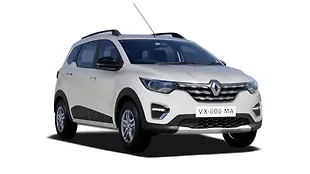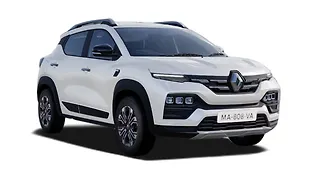Introduction
The Renault Kiger is the French automaker's first-ever B-SUV in the Indian market. In terms of pricing, it has undercut all its rivals to be the most affordable one. It is available in a couple of powertrain choices, manual and automatic transmission options, is feature-packed, and good-looking as well.

The Kiger is no doubt stunning. In fact, Renault's tagline says - Go where your curiosity takes you with the Kiger! This time, it has got us to a fuel pump. And reasonably so, because you have shown keen interest in knowing how much fuel efficiency the car returns.
How are we doing this?
As you must have seen in our previous tests, or like what we did with its close sibling, the Nissan Magnite, we'll be following the same process with the Kiger. Two tests will be undertaken - a city fuel efficiency run and another highway fuel economy run. At the end, we will provide you with a combined figure.
Tanking up

We fill the car’s tank up to the brim and start our journey on to our loop where we take all our test cars. Do note we are testing the 1.0-litre turbo manual variant of the Kiger here. It's powered by Renault's three-cylinder 1.0-litre turbo-charged petrol engine producing 99bhp and 160Nm of torque. In this case, it's mated to a five-speed manual gearbox, with power, of course, sent to the front wheels. Its ARAI-rated fuel efficiency is 20kmpl and we'll see how it turns out to be in the real world. First the city run.
City Fuel efficiency
As with all cars equipped with driving modes, we are going to do the same with the Kiger. Half of the test in the Eco driving mode and the other half in normal driving mode. We set the Kiger first in the Eco mode by selecting it from the multi-sense drive modes. It does change the instrument cluster with information showing up mostly in green. The usual drive mode is in blue and the Sport mode brings up everything in red. And now that we are speaking of the Sport mode, let me tell you, our V-Box tests done earlier have proved the Kiger to be the fastest in the segment. It clocked the 0-100kmph sprint in 10.20 seconds, just ahead of its sibling the Magnite that took 10.28 seconds.

Well, I've had enough fun in its Sport mode and shouldn't complain that I'm in the Eco mode now. But, I have to say, the Eco mode does take away the fun part. The throttle inputs aren't as sharp and there's no instantaneous supply of power. That said, it's not like the car feels dead. It still manages to keep up with the traffic. After all, when you are aiming at a good fuel economy that's something that you can easily live with.

It's time we shift to the normal driving mode and I love this transition. You suddenly have this extra pep and better throttle response. Even our in-gear acceleration runs in this mode, especially the 20-80kmph sprint in third gear, was achieved in 11.24 seconds. This clearly hints at its good drivability. And it goes without saying what a big advantage it has over the big burly SUVs. Thanks to its compact size, fitting it in gaps is easier than fitting blocks correctly in the Tetris game. Pottering around town is easy with its light controls, providing a good view of the road ahead and squeezing into tight spots as we got back to refuel at the pump. A fuel efficiency of 13.27kmpl in the city. Not bad but not impressive either. So, without wasting time or fuel, we'll get to the highway fuel economy.

Highway Fuel efficiency

We repeat the same process. The first half in Eco mode and the other in normal driving mode while we take on the highways where there's lesser traffic and higher average speeds. I've heard many say this three-cylinder mill isn't meant for the highway and I can understand why they might say that. One - the refinement levels are not great as when you rev the engine more than 4,000rpm, it does get quite noisy. Two - it feels strained at such high revs. However, the good thing is, you'd seldom be revving so hard. It can do 70-80kmph in fifth gear and the revs are just a little above 1,500rpm.

Even our V-box test of the 40-100kmph run in fourth gear shows the car took 15.47seconds. This is actually not bad for an SUV and is in the ballpark of its rivals. It shows that apart from its agility, the 160Nm of torque does help in keeping it going, and not leaves you wanting for more power. The car's light weight has also helped largely here. Also, with its smooth gearshifts and short throws, you won’t complain about rowing through the gears. Interestingly, it has enough boost to help you overtake a long vehicle and that too without making you feel nervous.

Before we forget, the Kiger also shows up a whole load of information on your infotainment screen as well. In fact, it also gives out scores on the way you've been driving which can also act as tips and suggestions to better your driving score. We've tried not to extract more in this run, but in fact, tried to emulate how an owner would be driving on his usual trip with a mix of city roads and highways. We tanked up the car again and the highway fuel economy came up to 18.96kmpl. This time, I'm impressed!
Conclusion
| Fuel economy | City | Highway | Combined |
| Renault Kiger | 13.27kmpl | 18.96kmpl | 16.14kmpl |
Now, as we take a look at the chart, the previous city fuel efficiency of 13.27kmpl and a highway fuel economy of 18.96kmpl brings us to a conclusion of a combined fuel economy of 16.14kmpl. Now, that's a figure an owner wouldn't mind for a petrol car. Especially when it is turbocharged, provides a sprightly performance, and of course, checks the other boxes when looking for a compact SUV.
So, the Kiger then was anyway an exciting option to consider. Now with these fuel efficiency figures, we know owners will have a little less to worry about the ever-increasing fuel prices.
Pictures by Kapil Angane and Kaustubh Gandhi

![Renault Kiger [2021-2022] Image Renault Kiger [2021-2022] Image](https://imgd.aeplcdn.com/272x153/n/cw/ec/44407/kiger-exterior-right-front-three-quarter-12.jpeg?q=80)
























